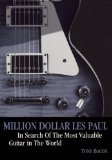For guitar collectors, Gibson Les Paul models made from 1958 through 1960 represent the holy grail of guitars. In the recent past, the value of Les Paul’s made during this period have skyrocketed, going for multiple hundreds of thousands of dollars. As of this writing, Gruhn Guitars here in Nashville has three 1959 Les Pauls each of which are in the $250,000 range and a fourth going for $325,000.
Growing up, I was always drawn to the Fender Stratocaster. Most of my guitar heroes played the Stratocaster at one time or another. However, in recent years, I’ve been drawn more and more to the history and sound of the Les Paul. Additionally, as someone who would love to build a guitar collection some day, I’ve been fascinated with these guitars and why they’re worth so much. So, I was intrigued when I saw Tony Bacon’s book Million Dollar Les Paul: In Search of the Most Valuable Guitar in the World in a local book store.
In the book, Bacon attempts to find out if one of these historic models has ever been sold for $1,000,000. In the process, he provides a thorough history of the Les Paul and some of its most famous players, including Les Paul himself. Bacon gives both competing histories regarding the origin of the Les Paul model, both Ted McCarty’s and Les Paul’s version. Regardless of which story is true, the first Les Paul model was launched by Gibson in 1952. The guitar had a gold top, which was Paul’s idea. Because the guitars were selling well, two more models were introduced in 1954, the Les Paul Junior and the Les Paul Custom. In 1958, Gibson decided to make a change to the Les Paul model; instead of a gold top, they offered a sunburst top, and the history of the Les Paul was forever changed.
Remarkably, by late 1960, sales of the sunburst Les Paul were declining and Gibson introduced the SG line of guitars, and the Les Paul became an afterthought for a number of years. Bacon postulates that approximately 1,450 sunburst Les Pauls were made between 1958 and 1960.
In the 1960s, the unlikely rise of British blues led to increased interest in the sunburst Les Paul. Players like Eric Clapton, Jeff Beck, and Peter Green helped solidify the place of the Les Paul guitar in history.
In the book, Bacon also describes the components of the guitar and how they helped shaped its collectibility. For instance, the Patent Applied For (PAF) humbuckers used in the late 50s model guitars have a mystique and collectibility all their own.
Due to demand, Gibson reintroduced the Les Paul Standard model in the 1970s. However, according to many players, it took Gibson a number of years to get the guitar “right” in comparison to the famous late 50s models. Even today, you’ll find arguments in Internet forums about whether they truly are reproducing the Les Paul accurately.
Throughout his exploration of the history of the Les Paul, Bacon interweaves insights into why the Les Pauls from 1958-1960 are so collectible from collectors and historians. It’s interesting to read the insights; you can tell that the people interviewed in the book are passionate about the guitar.
A nice addition to the book is the photographs of some famous Les Pauls, including guitars played by Duane Allman, Jimmy Page, Billy Gibbons, Paul Kossoff, Peter Green, Mike Bloomfield, Keith Richards, and of course Eric Clapton. Additionally, the book includes an interview with an owner of an early sunburst Les Paul, and interviews with guitarists Billy Gibbons, Joe Bonamassa, and Les Paul himself.
I thoroughly enjoyed this book. If you’re interested at all in the history of the Les Paul, I think you’ll enjoy Million Dollar Les Paul, too. Ultimately, he didn’t find definitive proof that a sunburst Les Paul model has ever sold for $1,000,000, but his journey provides for an excellent history of the Les Paul and its famous players.

The most valuable guitar in the world is the one you love most and play the most.
~ Z ~